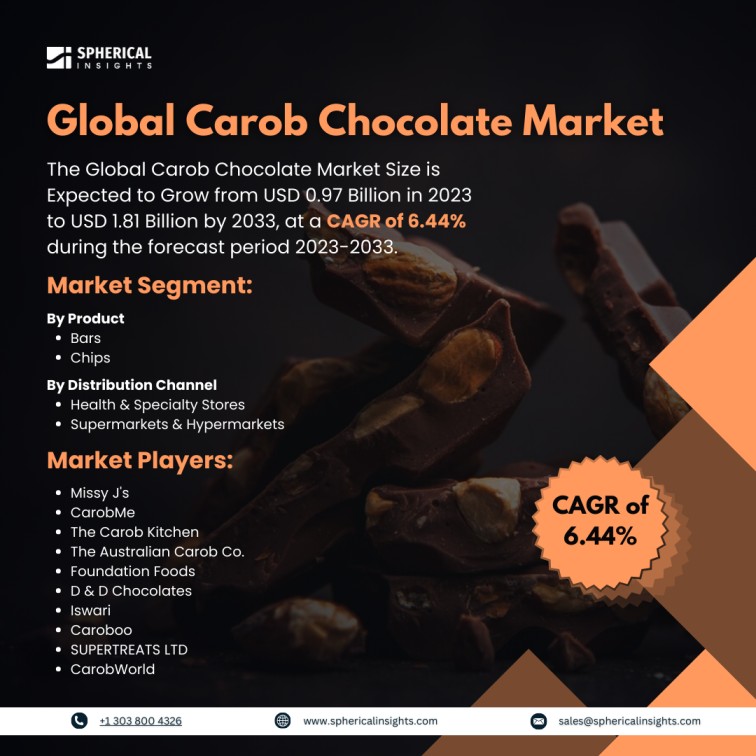Global Carob Chocolate Market Size to worth USD 1.81 Billion by 2033
According to a research report published by Spherical Insights & Consulting, the Global Carob Chocolate Market Size is Expected to Grow from USD 0.97 Billion in 2023 to USD 1.81 Billion by 2033, at a CAGR of 6.44% during the forecast period 2023-2033.
Browse key industry insights spread across 210 pages with 110 Market data tables and figures & charts from the report on the Global Carob Chocolate Market Size, Share, and COVID-19 Impact Analysis, By Product (Bars and Chips), By Distribution Channel (Health & Specialty Stores and Supermarkets & Hypermarkets), and By Region (North America, Europe, Asia-Pacific, Latin America, Middle East, and Africa), Analysis and Forecast 2023 – 2033.
The carob chocolate market is a specialized segment of the confectionery industry, focused on chocolate alternatives made from carob, a naturally sweet and caffeine-free legume. This market has gained significant attention due to the increasing demand for healthier confectionery options, driven by growing consumer awareness of health and wellness. Carob chocolate is known for its lower fat content, absence of caffeine, and suitability for individuals with dietary restrictions, such as those who are lactose-intolerant or allergic to cocoa. Moreover, the growth of the carob chocolate market is primarily propelled by the rising popularity of plant-based and vegan diets, coupled with an increasing inclination toward organic and gluten-free products. The health benefits associated with carob, including its high fiber content and antioxidant properties, further bolster market demand. Additionally, the expansion of specialty food retail outlets and the growing influence of e-commerce platforms have contributed to the accessibility and visibility of carob chocolate products. However, the market faces certain challenges, including limited consumer awareness in some regions and a comparatively higher price point than traditional chocolate.
The bars segment accounted for the highest share in 2023 and is expected to grow at a significant CAGR during the forecast period.
Based on the product, the carob chocolate market is divided into bars and chips. Among these, the bars segment accounted for the largest share in 2023 and is expected to grow at a significant CAGR during the forecast period. The dominance of the bars segment can be attributed to the convenience and portability of carob chocolate bars, making them a popular choice among health-conscious consumers seeking on-the-go snacking options. Furthermore, the availability of innovative flavors and formulations in carob chocolate bars has enhanced their appeal across diverse consumer groups.
The supermarkets & hypermarkets segment accounted for the largest share in 2023 and is expected to grow at a significant CAGR during the forecast period.
Based on the distribution channel, the carob chocolate market is classified into health & specialty stores and supermarkets & hypermarkets. Among these, the supermarkets & hypermarkets segment accounted for the largest share in 2023 and is expected to grow at a significant CAGR during the forecast period. The prominence of this segment is attributed to the widespread availability of carob chocolate products in large retail outlets, offering consumers the convenience of a one-stop shopping experience. These stores often feature attractive product displays and promotional activities, further driving sales.
North America is estimated to hold the greatest global carob chocolate market share over the forecast period.
North America is estimated to hold the greatest global carob chocolate market share over the forecast period. The region is experiencing growth due to growing consumer awareness of healthier food options and the popularity of plant-based and dairy-free products. A well-established health and wellness culture in the region has led to the demand for carob chocolate as a healthy alternative to traditional chocolate. In addition, the dominance of the region is considerably attributed to major market players and extensive distribution networks in North America. As consumers seek healthier and more innovative food products, the North American carob chocolate market will continue to hold the top position.
Asia-Pacific is predicted to have the fastest CAGR growth in the global carob chocolate market over the forecast period. More significant drivers include greater consumer awareness of healthier alternatives to traditional chocolates and increased demand for plant-based products. Moreover, the recent Plant-Based Foods and Proteins Summit Asia 2023 in Singapore showed how rapid innovation and product launches are driving consumer consumption of the same in the region.
Competitive Analysis
Major key players in the global carob chocolate market are Missy J's, CarobMe, The Carob Kitchen, The Australian Carob Co., Foundation Foods, D & D Chocolates, Iswari, Caroboo, SUPERTREATS LTD, CarobWorld, and Inc.
Key Target Audience
- Market Players
- Investors
- End-users
- Government Authorities
- Consulting And Research Firm
- Venture capitalists
- Value-Added Resellers (VARs)
Recent Development
- In October 2024, Foreverland raised €3.4 million to revolutionize the chocolate world with carob. The Italian startup, which invented a sustainable carob-based chocolate alternative, redefined the future of chocolate and the food industry with this funding round. The funds were aimed at launching its semi-finished product manufacturing facility and expanding into Europe.
Market Segment
This study forecasts global, regional, and country revenue from 2023 to 2033. Spherical Insights has segmented the global carob chocolate market based on the below-mentioned segments:
Global Carob Chocolate Market, By Product
Global Carob Chocolate Market, By Distribution Channel
- Health & Specialty Stores
- Supermarkets & Hypermarkets
Global Carob Chocolate Market, By Regional Analysis
- North America
- Europe
- Germany
- UK
- France
- Italy
- Spain
- Russia
- Rest of Europe
- Asia Pacific
- China
- Japan
- India
- South Korea
- Australia
- Rest of Asia Pacific
- South America
- Brazil
- Argentina
- Rest of South America
- Middle East & Africa
- UAE
- Saudi Arabia
- Qatar
- South Africa
- Rest of the Middle East & Africa



